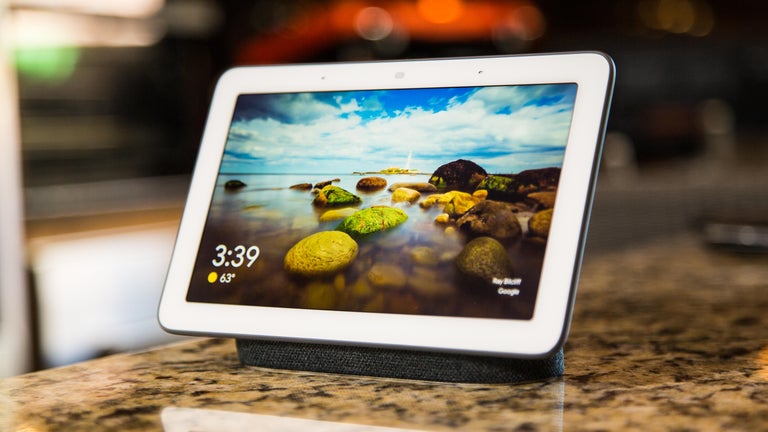
The Google Home Hub is a visual, touchscreen-based interface that’s designed to help you navigate daily life.
The device can do things like guide you through a morning or evening routine, watch the news, follow recipes, and even make calls.
Simply put, the Google Home Hub is a visual interface which is meant to help you accomplish everyday tasks. It looks like a tablet, and is focused on making your life easier, from organizing your schedule to making grocery lists.
50% off Google Home Hub. Limited Time!What can the Google Home Hub do?
The Google Home Hub can do things like:
- Allow you to view your daily schedule, commute, and reminders
- Control compatible lights, cameras, and TV’s
- Access “visual, immersive” answers to your questions about things like recipes, local weather and businesses, and more
- Play music
- See your photos in Google Photos
- Watch the news
- Make calls (in the U.S., these only work domestically)
- Create shopping lists
- Secure your house and control your thermostat (if your systems are compatible)
- Control other compatible smart devices, like Google Home
The confusing part is that it has evolved over time, and there is now a 2nd Gen Google Hub that is called the Nest Hub. It has more features but the basic goals of functionality is the same.
Google Nest Hub (2nd gen)
Google refreshed its most popular smart display, lowered the cost and added one eyebrow-raising feature: sleep tracking.
If you own a Google smart display, chances are it’s the first-generation Nest Hub. There have been others: the Lenovo Smart Display powered by Google Assistant or the pricey, camera-equipped Nest Hub Max. At $130 and often on sale, the smaller Nest Hub was the go-to for many smart home consumers.
Now, there’s a new model replacing it. The second-gen Nest Hub is cheaper at $100 (£90, AU$149) and smarter too. What’s not to love? Well, like Amazon’s Echo Show 10, Google showed up with a new feature that might creep you out: Sleep Sensing.

LIKE
- More affordable
- Quick Gestures for hands-free control
- Edge-to-edge glass
- Bigger bass
DON’T LIKE
- Sleep Sensing is only free for the time being.
- Big bezel remains
- No camera means no video chat.
Yes, Sleep Sensing is the shiny new feature on the second-gen Nest Hub, but that’s not the whole story. The new Nest Hub is also 30% cheaper than the original, with 50% more bass, new color options and a more eco-friendly design. Google’s new and improved smart display is the best bet for most smart homes.
Sleep Sensing
The big feature headlining the new Nest Hub is Sleep Sensing. It uses Google’s miniature radar technology called Soli to detect submillimeter movements of the person sleeping closest to the display.
During setup, a visual guide shows you where to place and aim the display and asks you to get into your normal sleep position for a few seconds of calibration. After that, you’re good to go. A small icon appears on the top right corner of the display when it senses someone in bed, and a larger, banner notification pops up when the display begins tracking sleep.
The Nest Hub also offers a Respiratory Wellness feature that records how often the display heard coughing or snoring during the night, as well as your respiratory rate (the number of breaths you take per minute) during sleep.
Audio
Google says the new Nest Hub has 50% more bass than the previous model. Google added a third microphone to this model for better listening, too. That’s one more than the previous Nest Hub and one more than the Nest Hub Max, too. The switches and buttons that mute the microphones and control volume remain unchanged.
This isn’t Nest Audio, so don’t expect premium sound out of a device that’s first and foremost a screen. However, it’s plenty loud enough and offers great quality for everyday entertaining. Paired in a speaker group with other Nest speakers, it keeps up and performs well.
More Features
When it comes to smarts, all the updates are internal and future-focused. Like the Nest Hub Max and Nest WiFi, the new Nest Hub has built-in support for Thread, a wireless, low-energy IPv6 protocol that makes connecting third-party smart home devices simpler. Thread functionality isn’t turned on yet for new Nest Hubs, but Google’s continued inclusion of Thread is a nod to Project Connected Home Over IP, aka CHIP, an effort led by Apple, Amazon, Google and the Zigbee Alliances to create a universal smart home standard. Right now, other Thread-certified devices include products from Nanoleaf and Eve, among others.
This Nest Hub also includes the same machine-learning chip found on the latest Nest Mini and Nest Audio, Google’s most affordable smart speaker. That ML chip processes your most common commands locally, helping Google Assistant speed up response time.
You’ll still be able to stream video from YouTube, Netflix, and Disney Plus and more on the 7-inch HD display. Music streaming from Apple Music, Spotify, YouTube Music and Pandora are there as well. You’ll also find tabs for Photo Frame, Your Day, Home Control, Wellness, Media, Communicate, Family and Discover.
You can view cameras, doorbells, thermostats, lights and more from the Home Control tab. There’s still no built-in camera. While that’s a personal preference, I’m happy to see Google stay the course on offering a camera-free smart display.
Overall
With sensible updates, a lower price and more capability, the second-gen Nest Hub is a worthy successor to the original model. New features that might make some folks nervous are totally optional and you can review and delete your data at any time.
Sources: CNet.com; Businessinsider.com





